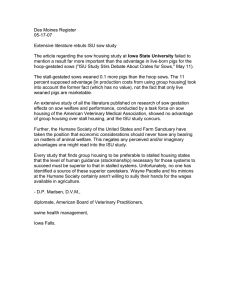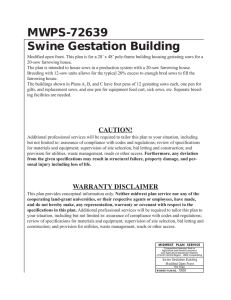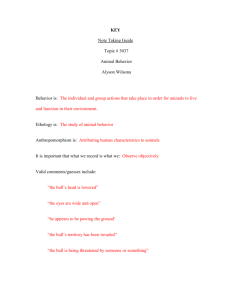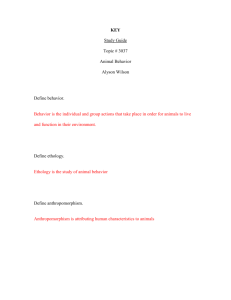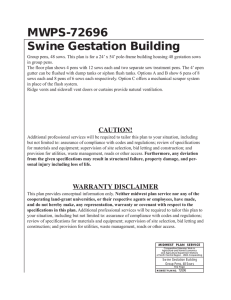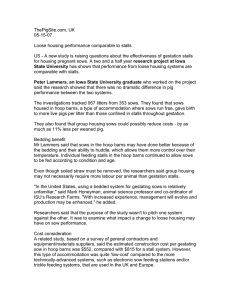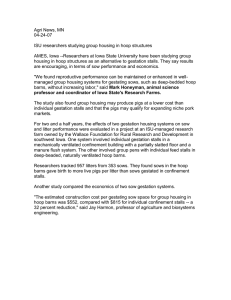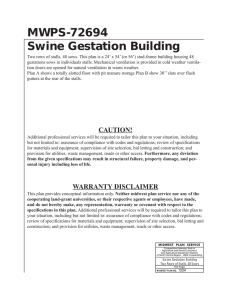J. J. McGlone, B. Vines, A. C. Rudine and P.... 2004, 82:2421-2427. The physical size of gestating sows
advertisement
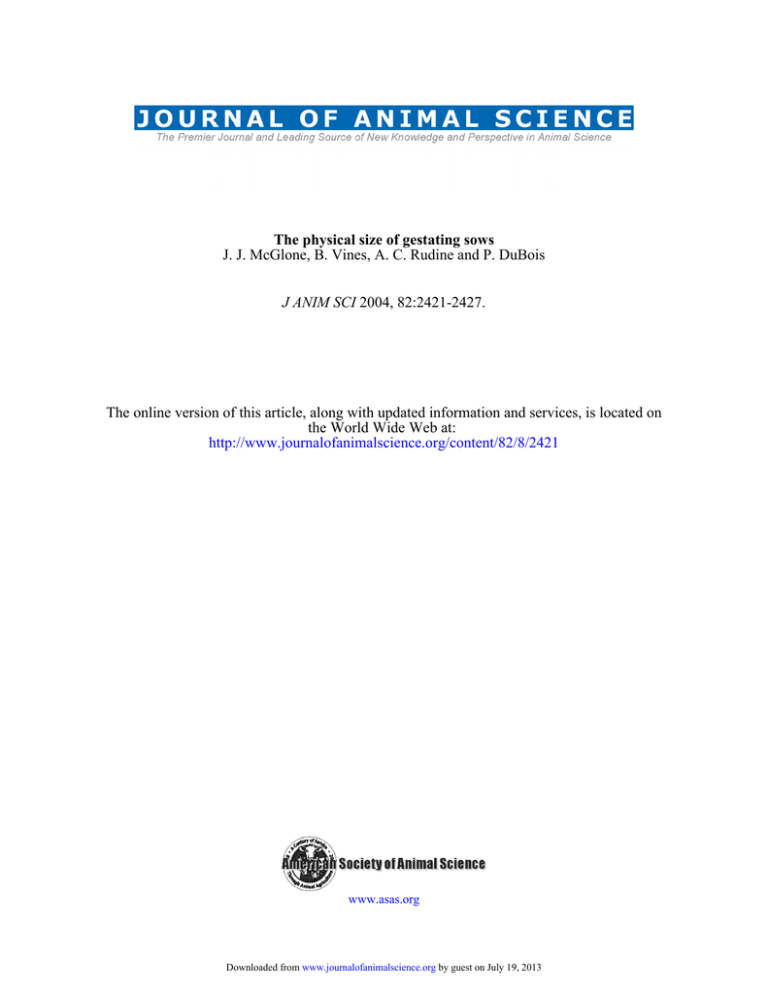
The physical size of gestating sows J. J. McGlone, B. Vines, A. C. Rudine and P. DuBois J ANIM SCI 2004, 82:2421-2427. The online version of this article, along with updated information and services, is located on the World Wide Web at: http://www.journalofanimalscience.org/content/82/8/2421 www.asas.org Downloaded from www.journalofanimalscience.org by guest on July 19, 2013 The physical size of gestating sows1 J. J. McGlone*2, B. Vines†, A. C. Rudine*, and P. DuBois† *Pork Industry Institute, Department of Animal and Food Sciences, Texas Tech University, Lubbock 79409-2141, and †Cargill Pork, Inc., Russellville, AR 72811 ABSTRACT: Two hundred ninety-six gestating sows were used to determine the physical dimensions of sows in commercial settings. Sows were examined from five farms within a single production model that included identical feed formulation, management practices, herd health, and similar, but not identical, genotypes. Sows were individually weighed, backfat thickness was determined by ultrasound, and body dimensions were determined. Sow body length, height, width (lateral length, left to right from midline), and depth (measured as distance from ventral to dorsal extremes) were also determined. Regression procedures were used to model the changes in sow body size in relation to parity, BW, and stage of gestation within and among genotypes. Farm-to-farm variation in sow dimensions for the same genotype was also determined. Least squares means, SD, and 95% upper confidence limits of this sample are presented. Sows increased (P < 0.001) in body dimensions by predicable levels with parity (r2 = 0.92) up to Parity 6, and with advancing pregnancy (r2 = 0.99). Sows of different but related genotypes differed (P < 0.01) in body length, width, height, and depth. Sows of the same genotype, fed the same feed formulation, differed in body dimensions when managed on different farms. Based on mean values and a 95% confidence interval, stall width would need to be at least 72.4 cm to accommodate all sows on the farm. These data and models can be used to design stall sizes and farm floor space needs to meet current animal welfare recommendations. To accommodate the body size of pregnant sows on commercial farms, stall sizes for the majority of sows would need to increase, as would the total floor space needed for a given number of gestating sows individually penned in conventional production systems to meet recently published guidelines. Key Words: Body Dimensions, Pigs, Sow, Welfare 2004 American Society of Animal Science. All rights reserved. Introduction The majority of sows in the United States are housed in confinement facilities (USDA, 2001). The most common housing system for pregnant sows in confinement involves individually keeping sows in gestation stalls or, less commonly, in tethers. The gestation stall does not allow sows enough space to turn around, but they are able to stand up and lay down. The amount of space required for sows to lay down in full lateral recumbency is unknown. Recent guidelines issued by food retailers and the National Pork Board (NPB) suggested that sows should be in a pen or stall that allows them to lie down J. Anim. Sci. 2004. 82:2421–2427 without parts of their body (not including their limbs) extending into the neighboring sow’s stall (NPB, 2002). The National Council of Chain Restaurants and the Food Marketing Institute have suggested that pregnant sows should be able to lie down without their teats extending into their neighbor’s stall (NCCR, 2002). The objective of this study was to describe as a first approximation the body dimensions of a sample of pregnant sows on selected commercial farms in the United States. Variables such as farm source, parity, and stage of gestation were used to develop models to predict the physical dimensions of sows in such a way that stall dimensions could be engineered to meet industry and consumer requirements. Materials and Methods 1 The authors thank L. McCuiston and the staff at the Glenwood, AR office of Cargill Pork for technical assistance during this study. 2 Correspondence—phone: 806-742-2826; fax: 806-742-2335; email: john.mcglone@ttu.edu. Received August 25, 2003. Accepted April 19, 2004. This project was approved by the Texas Tech University Animal Care and Use Committee. All farm husbandry procedures were consistent with published guidelines (FASS, 1999). 2421 Downloaded from www.journalofanimalscience.org by guest on July 19, 2013 2422 McGlone et al. Table 1. Numbers of sows sampled overall and for the XY genotype Parity No. of sows of any genotype No. of XY sows 1 2 3 4 5 6 7 8 9 10 Total 32 46 89 46 41 16 12 12 1 1 296 31 32 53 42 30 9 11 12 1 1 222 All sows were randomly selected from farms under contract with Cargill Pork (Russellville, AR). Under the contract, Cargill Pork owned the sows and the contract growers owned the facility and provided daily, routine husbandry. Cargill Pork supplied the feed, supplies, and technical assistance. The farms were in a common geographical location, and they received breeding stock, feed, and supplies from a common source. The names of the sampled farms and specific genetic lines are confidential; however, the building designs used, the production schedule, and the farm sizes were similar. Farms had approximately 500 sows each. Each farm had a weekly production schedule with 20 groups of sows. Sows were evaluated daily for estrus with a boar after weaning and confirmed pregnant with an electronic pregnancy tester 28 to 35 d after mating. Sows and piglets were weaned when piglets were between 14 and 23 d old, with an average weaning age of approximately 17 d of age. Five sow units were visited and a total of 296 sows were measured (Table 1). The sows represented three genotypes, all representing commercial maternal lines. The core sample was taken on 222 sows of a genotype designated as XY from three farms to assess variation among farms with identical genetics. The XY genotype represented a cross between a Yorkshire × Landrace maternal line (Line X) and a maternaltype boar line developed by another breeder (Line Y). At the time of the study, the XY genotype was the genotype available in the largest numbers. Other data were collected for comparison purposes on two other genetic lines derived from lines using Yorkshire, Landrace, and Duroc breeds. These genotypes are designated X and XZ. Genotype X was the maternal line that, when bred to a different sire line, created line XZ (thus, X is the maternal line parent for line XZ). All sows had white skin and were crossbred commercial, maternal-line sows. Sows were measured with specially designed calipers, a ruler, and a tape measure. The accuracy or sensitivity of instruments was less than 1 mm for all measures. The electronic calipers (electronic digital caliper, Fowler, Boston, MA) were modified by adding extensions to allow them to reach to the widest part of the sows’ body. A team of people that included two standard observers and various animal handlers collected morphometric measures and measures of BW and backfat thickness. Physical measures included sow height, depth, width, and length. All measures were collected while the sows were standing on a level surface. Some sows are taller at their last rib and others are tallest near their hip. Height was measured from the floor to the dorsal surface of the last rib and to the dorsal surface of the back at the hip. A measure of sow depth was used to estimate sow width while lying down. Depth was measured at the last rib from the dorsal surface to the ventral surface. This measure was also the height (at the last rib) minus the distance from the floor to the ventral surface. Width was measured at the ham, last rib, and shoulder. Length was measured in two ways. The total body length was measured from the tip of the snout to the posterior of the sow. A second length measure was an approximation of body length and included the anterior scapula to the posterior of the sow, which equals the body length not including the head. Each sow’s parity and day of gestation were recorded. All sows had been confirmed pregnant by ultrasound before being measured. Day of gestation ranged from 23 to 115. Sow parities were from Parity 1 (gilts) to 10. However, only one Parity 9 and one Parity 10 sow was sampled. Table 1 shows the number of sows of each parity that were examined in the entire dataset and for the XY genotype that represented the majority of animals sampled. Data were analyzed by use of regression procedures in EXCEL (Microsoft, Redmond, WA), and regression and general linear models procedures with SAS software (SAS Inst., Inc., Cary, NC). For all studies, the sow was considered the experimental unit. For farmto-farm comparisons, the farm represented a treatment. For these analyses, the model included the effects of farm with sow parity and day of gestation as covariates and only one genotype (the predominant XY genotype) was included. For genotype comparisons, the genotypes were found on three or more farms. Because farms and genotypes varied in average parity and day of gestation among the sows sampled, sow parity and day of gestation were included in the GLM as covariates when whole-farm or genotypes were evaluated. In no case were the farm interactions with parity or day of gestation significant (P > 0.10). After the initial data analyses, models were developed to reflect commercial farms. For the example presented, a 500-sow farm with the XY genotype was considered. On this model farm, a certain parity distribution was assumed (based on a common farm parity distribution). It might be impractical to have a gestation stall size for sows of each parity; therefore, two models were considered. In one model farm, there Downloaded from www.journalofanimalscience.org by guest on July 19, 2013 2423 Pregnant sow dimensions Table 2. Morphometric measures of sow body size during gestationa 95% Lower limit Mean Standard deviation 95% Upper limit 147.1 0 8.8 239.9 3.7 20.5 46.4 2 5.9 332.7 7.6 32.2 360 10 42 Height, cm Floor to dorsal surface at last rib Floor to dorsal surface at hip 77.0 74.4 88.4 88.1 32.0 37.8 100.1 101.6 102.1 99.6 Depth, cm At last rib, dorsal to ventral surface 43.7 57.7 7.1 71.6 78.0 Width, cm Ham Last rib Shoulder 32.3 27.2 33.5 38.1 35.6 40.4 2.8 4.3 3.6 43.7 43.9 47.5 45.0 45.5 51.8 141.7 96.8 171.2 115.6 14.7 9.4 200.9 134.6 205.0 147.6 Measure Weight, kg Parity Backfat, mm Length, cm Snout to posterior Anterior scapula to posterior Maximum value a Sows were Parities 1 to 10, n = 222 XY sows. were two stall sizes and in another model, three stall sizes were considered. For these models, the 95% confidence interval (CI) was constructed about the least squares means to reflect the upper limit of gestating sows in our core dataset (222 sows of the XY genotype). Results Morphometric data are summarized in Table 2 for the XY genotype. Presented in the table are the means, the standard deviations, the upper and lower 95% CI, and the maximal single value in the dataset. Mean sow depth increased through Parity 7 and decreased for sows in Parity 8. Because we sampled only one sow each in Parities 9 and 10, these data Figure 1. Sow depth increased with parity up to Parity 6.3; however, the least squares mean for depth of Parity 4 sows did not differ (P < 0.10) in depth from later parity sows. n = 222 pregnant XY genotype sows. were excluded from the analyses. The average parity data are plotted in Figure 1. The regression equation that best fit the data was a second-order polynomial (R2 = 0.92). A response surface regression procedure within SAS was used to calculate the peak in body depth over parity for the mean and the upper 95% CI. The peak in sow body depth was calculated to be at 6.3 parities. The same peak parity value was obtained for both the mean and the 95% CI data. The mean values for sow body depth over day of gestation are shown in Figure 2. The earliest sows were confirmed pregnant as a part of our sample was at 23 d after mating. Thus, the data for gestation d 0 through 23 were by extrapolation and as such, the predicted values were less reliable before d 23 of gestation than other day of gestation. Sow depth increased with advancing pregnancy in a linear manner (r2 value Figure 2. Effects of day of gestation on sow depth. The points on the line represent the average sow depth on each day of gestation. The increase in body depth over the course of gestation was linear. Data are for the range of d 23 to 114 of gestation. n = 222 XY sows. Downloaded from www.journalofanimalscience.org by guest on July 19, 2013 2424 McGlone et al. Table 3. Morphometric sow measures from XY genotype sows on three farms Farm Measure A No. of sows Weight, kg Parity Days of gestation Backfat, mm 236.0 3.7 74.7 19.4 B 61 ± 3.3a ± 0.25 ± 3.6 ± 0.7a 228.30 3.5 67.0 18.6 89 ± 2.8a ± 0.20 ± 3.0 ± 0.6a C 257.5 3.8 73.3 23.9 72 ± 3.0b ± 0.23 ± 3.3 ± 0.6b P-value — 0.001 0.52 0.19 0.001 Height, cm Floor to dorsal surface at last rib Floor to dorsal surface at hip 88.1 ± 0.6 86.6 ± 0.69a na 88.1 ± 0.57ab 88.9 ± 0.5 89.3 ± 0.63b 0.29 0.02 Depth, cm At last rib, dorsal to ventral surface 58.0 ± 1.1 57.7 ± 0.9 57.4 ± 1.0 0.90 Width, cm Ham Last rib Shoulder 37.9 ± 0.3a 36.0 ± 0.4a 40.3 ± 0.3a 37.4 ± 0.2a 34.3 ± 0.3b 39.7 ± 0.3a 39.0 ± 0.3b 36.5 ± 0.3a 41.7 ± 0.3b 0.001 0.001 0.001 169.2 ± 1.3a 112.8 ± 0.9a 169.1 ± 1.1a 115.9 ± 0.8b 175.9 ± 1.2b 117.6 ± 0.8b 0.001 0.001 Length, cm Snout to posterior Anterior scapula to posterior a,b Least squares means within a row that do not have common superscripts differ, P < 0.05. Sow parity and day of gestation were used as covariates in the analyses. na = data not available. of 0.99). Body depth the pregnant sows increased 1.2 mm/d on average from d 23 through 115 of gestation. The regression line in Figure 2 represented average data over the 222 sows of the XY genotype. Sows in this sample were widest at the shoulder compared with width at the ham or last rib (Table 2). Shoulder width was a maximum of 51.8 cm; thus, sows should be contained within a stall that is wider than 52 cm (inside width). Sows of a common genotype fed a common diet formulation and in similar facilities varied from farm to farm. Presented in Table 3 are the least squares means for three farms (labeled A, B, and C) for each morphometric measure. Sows on Farm C were heavier and had greater backfat thickness than sows on the other two farms. In addition to being heavier, the sows on Farm C were wider at the ham and shoulder and longer overall (snout to posterior) than the sows of Table 4. Summary of selected sow measures from sows of three related genotypes Genotype Measure XZ No. of sows Weight, kg Parity Days of gestation Backfat, mm 233.0 2.9 108.6 19.7 29 ± 5.6 ± 0.3a ± 4.5a ± 1.1 XY X P-value 222 241.0 3.7 ± 0.1b 71.2 ± 1.6b 20.7 ± 0.4 40 na 3.9 ± 0.3b 99.0 ± 3.9a na — 0.18 0.05 0.001 0.40 Height, cm Floor to dorsal surface at last rib Floor to dorsal surface at hip 82.3 ± 4.4 86.8 ± 5.3 88.6 ± 0.4 88.2 ± 0.4 87.9 ± 0.8 87.3 ± 0.9 0.30 0.65 Depth, cm At last rib, dorsal to ventral surface 55.9 ± 1.6a 58.5 ± 0.5a 61.6 ± 1.3b 0.01 Width, cm Ham Last rib Shoulder 40.1 ± 0.4a 35.7 ± 3.0a 40.5 ± 2.7ab 38.3 ± 0.2b 35.9 ± 0.2a 40.7 ± 0.2a 40.8 ± 0.4a 38.2 ± 0.5b 43.5 ± 0.4b 0.001 0.001 0.001 172.3 ± 10.5ab 108.0 ± 7.4a 171.8 ± 0.7a 115.9 ± 0.5a 166.7 ± 1.8b 123.2 ± 1.2b 0.030 0.001 Length, cm Snout to posterior Anterior scapula to posterior a,b Least squares means in a row that do not have common superscripts differ, P < 0.05. Sow parity and day of gestation were used as covariates in the analyses. na = data not available. Downloaded from www.journalofanimalscience.org by guest on July 19, 2013 2425 Pregnant sow dimensions Table 5. Model of a 500-sow farm and the associated number of sows with each deptha Parity Item 1 Percent in herd Sows in each parity Mean, cm Upper 95% CI, cmb 20 100 51.1 59.2 2 18 90 52.3 60.5 3 16 80 57.7 65.8 4 5 6 7 8 Total 14 70 61.2 69.3 12 60 61.2 69.3 8 40 62.0 70.1 6 30 64.3 72.4 6 30 60.2 68.3 100 500 — — Model stall size distribution Two-stall-sizes model Three-stall-sizes model Width 1 60.5 cm 60.5 cm % sows 38 38 Width 2 72.4 cm 69.3 cm % sows 62 48 Width 3 — 72.4 % sows — 14 a The model was based on the regression equations presented in Figures 1 and 2 and using the XY genotype and an estimated parity distribution. b CI = confidence interval. the same genotype on Farms A and B. Body length, not including the head (length from anterior scapula to posterior), was longer (P < 0.001) for sows on Farms C and B compared with sows on Farm A. From three farms, data were available on three related genotypes of sows. The data for sow body dimension for sow genotypes XZ, XY, and X are presented in Table 4. Because sow genotypes varied by parity and day of gestation, these two factors were included as covariates in the general linear models evaluation of sow body dimensions for each genotype. Sows of the X genotype were (P < 0.01) deeper, wider at the last rib and shoulder, and longer bodied (from anterior scapula to posterior) than genotypes XZ or XY. Sows of the XZ and X genotypes were wider (P = 0.01) at the ham than were sows of the XY genotype. Sows increased in depth as day of gestation progressed (as in Figure 2), but they lost body depth after farrowing, lactation, and being returned to the breeding area. With each subsequent parity, the starting and ending points for each gestation period increased. The result was a saw-tooth-shaped graphic with an overall positive slope. Models were constructed based on a 500-sow farm (Table 5). A certain parity distribution was inserted in the model, and the upper 95% CI for body depth was calculated for XY sows of each parity. Two conditions were assumed. One was that the farm would use two stall widths, and the other was that the farm would use three stall widths. Clearly, this model would change with genotype and parity distribution (among other factors). Discussion This study reports the first summary of morphometric measure for a sample of modern U.S.A. sows. Other regression equations are available for growing pig body dimensions (Baxter, 1984) and late-gestation sows (Curtis et al., 1989), but not for modern sows over multiple parities and days of gestation. One common gestation stall in commercial use has an inside dimension of less than 58 cm and a length of 213 cm. Based on the average and 95% upper CI (Table 2) in sow length, the majority of sows would be contained within 213 cm because the largest sow measured 205 cm and 95% of the sows were 201 cm or less long. Sow depth was measured and we suggest that this dimension approximately equaled an estimate of the sow width while lying. Future work needs to describe the changes in sow dimensions with different postures, although we expect sow dimensions to be highly correlated when sows assume different postures. Sows clearly became deeper with subsequent parity (up to Parity 6) and with each advancing day of gestation. On average, 95% of the sows in this sample (and with this parity distribution) would be contained, while lying down, in a stall with a width of 71.6 cm or greater. Based on these data, most gestation stalls are not wide enough to allow sows to be contained within the width of the stall while lying down. One methodological issue may be that the sow may vary in width when standing compared with width when lying down. We assume, for the time being, that the depth of sows is similar when she is standing or lying down. We chose to measure sows while standing because we thought we could obtain more accurate and repeatable measures of depth because they could stand uniformly, with all four feet supporting the body. If sows were arching their backs or standing awkwardly, the measurements were postponed until each sow adopted a normal standing posture. While lying down, sows adopt a variety of postures, including full or partial lateral recumbency, and obtaining uniformity of lying posture would be difficult if not impossible. Sows increased in body size, particularly depth, as parity and stage of gestation progressed (Figures 1 and 2). Sows’ body depth increased by about 1.2 mm/ d of gestation. This means that the pregnant sow is 127 mm deeper at the end of pregnancy than at the Downloaded from www.journalofanimalscience.org by guest on July 19, 2013 2426 McGlone et al. start of gestation. This information could be used to refine gestation stall designs to accommodate the changing size of the pregnant sow. Sows were examined on farms that had identical genetics and feed formulation, as well as very similar physical facilities. Farms with identical genetics varied in sow dimensions. Among potential causes of this effect, feed allocation per day may partially explain the observed farm-to-farm variation in height, width, and length, but not depth. Indeed, Farm C was delivered more feed per sow per unit of time than were Farms A or B. By feeding more and having sows with more backfat, the size of the sows will also understandably increase in weight and body width. Maintaining more body condition on sows will necessitate wider stall dimensions if sows are to be maintained in stalls that do not interfere with sow movements. Space can be defined in three ways. First, the static space needs of animals include the space required to physically accommodate or contain the body. Second, the dynamic space requirement of sows includes the space needed to make normal postural adjustments without being obstructed by pen materials. Finally, the social space is the space animals need to socially interact without obstruction. The gestation stall prevents complete social interaction, and thus the social space allowance cannot be met with a standard gestation stall. Baxter (1984) reported static space needs of pigs, but he did not consider sow sizes during gestation and parities. To understand the static and dynamic space requirement, Curtis et al. (1989) studied lategestation sow dimensions and movement in open spaces. They did not measure sow depth. Their static space requirements were 2 to 5% higher than the sows in our sample. We do not know whether the differences between the sows in the two studies are due to genetics, feeding levels, or other factors. One can only conclude that sow size varies from farm to farm. In the Curtis et al. (1989) study, the dynamic space requirement was almost exactly twofold higher than space estimates for the sow static width at the shoulders. One could use our data to estimate the dynamic space allowance in terms of stall width to be a width that is two-times greater than the shoulder width. At this stall width, sow depth (width while lying down) would be easily accommodated, but sows would be likely to be able to turn around. The effects of providing space allowances that barely allow sows to turn around may increase sow injuries (Anil et al., 2002a). As in our sample, Curtis et al. (1989) also found differences among genotypes in sow dimensions. Both studies used crossbred sow lines; however, their study was of conventional breed crosses, whereas our sample was from commercial breeding stock companies. It is clear that sow genotypes, even those that represent parents and offspring (as in our X and XZ lines) can vary significantly in dimensions. For example, the X line was deeper, wider, and shorter in length than the XZ line (Table 4). To address the practical issue of lying postures, Anil et al. (2002b) examined the postural behaviors of 25 sows. Based on videotape analyses of sow postural changes, they concluded that standard-width gestation stalls did not provide sufficient room for normal postural adjustments. Anil et al. (2002b) suggested that sows in gestation stalls were not in a comfortable state and that the problem became worse as pregnancy advanced. In general, our findings and the results of Anil et al. (2002a,b) are in agreement. Our results suggest that larger sows kept in a stall less than 57 cm wide might be in an uncomfortable position due to restricted stall width. Ninety-five percent of sows would be entirely contained in a stall that was less than 72 cm in width (Table 5). The height of the gestation stall is not considered a major issue in most cases because, among the majority of gestation stalls, the top of the stall is typically open, at least in part. The sows in our survey would be accommodated by a stall height of 102 cm. Many models could be generated from the dataset that was collected. In our attempt to provide a first approximation of the space needs on a commercial farm, we modeled a 500-sow unit (500 sows in gestation). We assumed a parity distribution that might be found on a commercial farm (the parity distribution could be changed in another model). If the farm wished to physically contain all sows without restriction, then the farm could have as many as seven stall widths. Standard stall lengths and heights could be used, although with these data those dimensions could likewise be refined. It seems unreasonable to have seven stall widths. Based on the sow dimensions collected during this study, if one used two or three stall widths, then all sows could be contained within the space widths given in Table 5. If a farm were built with larger stalls using the two-stall-size model, then the total stall floor space for the same number of sows would be increased by 16.3%. If more floor space were provided, the building and equipment cost per sow would increase. It is unknown whether this increase in space would have any effect on sow productivity. Implications Fewer than 40% of the sows in a conventional gestation stall (58 × 213 cm) are contained within the width of the conventional stall without protruding outside the bars or being compressed against the bars of the side walls. Conventional stalls are long and tall enough to accommodate the majority of sows. Management factors influencing the same genotype can cause sow dimensions to vary. Sow genotypes vary significantly in body dimensions. One formula cannot explain sow dimensions of the domestic pig across management systems and genotypes. Before individual gestation stalls can be engineered to accommodate the static space requirements of sows, precise body Downloaded from www.journalofanimalscience.org by guest on July 19, 2013 Pregnant sow dimensions dimensions must be obtained for each genotype, with accounting for farm-to-farm variation in common management practices. Literature Cited Anil, L., S. S. Anil, and J. Deen. 2002a. Evaluation of the relationship between injuries and size of gestation stalls relative to size of sows. J. Am. Vet. Med. Assoc. 221:834–836. Anil, L., S. S. Anil, and J. Deen. 2002b. Relationship between postural behaviour and gestation stall dimensions in relation to sow size. Appl. Anim. Behav. Sci. 77:173–181. Baxter, S. 1984. Pages 210–254 in Intensive Pig Production. Granada, London, U.K. 2427 Curtis, S. E., R. J. Hurst, H. W. Gonyou, A. H. Jensen, and A. J. Muehling. 1989. The physical space requirement of the sow. J. Anim. Sci. 67:1242–1248. FASS. 1999. Guide For the Care and Use of Agricultural Animals in Agricultural Animal Teaching and Research. Federation Anim. Sci. Soc., Savoy, IL. National Council of Chain Restaurants. June 2002 Animal Welfare Report. Available: http://www.nccr.net/newsite/index.html. Accessed January 30, 2003. NPB. 2002. Swine Care Handbook. National Pork Board, Des Moines, IA. USDA. 2001. Part I: Reference of Swine Health and Management in the United States, 2000. No. N338.0801. National Health Monitoring System, Fort Collins, CO. Downloaded from www.journalofanimalscience.org by guest on July 19, 2013 References This article cites 3 articles, 1 of which you can access for free at: http://www.journalofanimalscience.org/content/82/8/2421#BIBL Citations This article has been cited by 5 HighWire-hosted articles: http://www.journalofanimalscience.org/content/82/8/2421#otherarticles Downloaded from www.journalofanimalscience.org by guest on July 19, 2013
